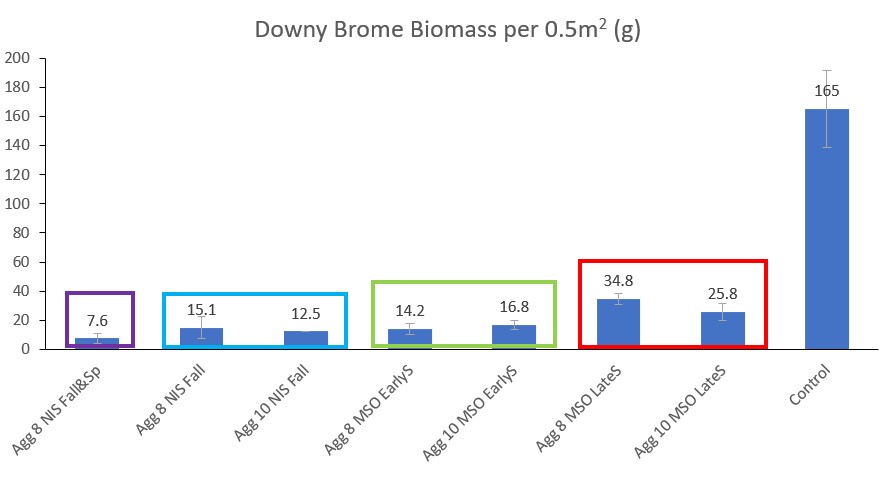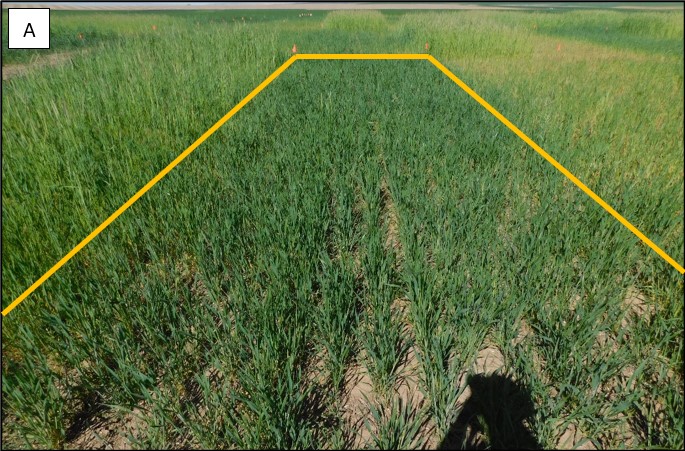You may have heard about the importance of the timely application of herbicides, or maybe even experienced it yourself. With the new CoAXium wheat varieties resistant to Aggressor (quizalofop), the question about when Aggressor should be applied to have the best weed control and crop yield out of the investment arises once again. That is the reason I would like to share my experiences of six years working with Aggressor in CoAXium wheat with you.
I remember that when I started to work with Aggressor, I was impressed with the downy brome (cheatgrass) control just with a single application in spring (8 – 12 fl oz/ac). In fact, I was rating many of the spring applications with 100% control when I couldn’t see any survivor downy brome plants. However, from a trial in 2018, one in 2021, and two trials this year (2022), I have become a fan of fall applications. Fall applications, when infestation is moderate or high, are the only ones that are going to protect your wheat yield. In Figure 1, you can see in a trial we conducted in a grower’s field with a very dense downy brome infestation, that the split and single fall applications had less downy brome biomass at harvest time and higher yields than the spring applications. Notice that the plots left untreated had 5 bu/ac compared to the 81 bu/ac obtained with a split application.
(Select photos to enlarge)
Figure 1. Results from different Aggressor (Agg) treatments in a CoAXium wheat trial in Adams, OR conducted in 2018. A) Wheat yield in bu/ac and B) Downy brome biomass (g) collected in frames of 0.5m2 before harvest. The treatments consisted in different application timing (split application, fall, early spring, and late spring), different herbicide rates (fl oz/ac), and different adjuvants (NIS = Non-ioninc surfactant, MSO = Methylated Seed Oil). Number above the bars indicate the treatment mean and bar whiskers the standard deviation of the data.
Last year, in one of the CoAXium wheat trails that we conducted at the Columbia Basin Agricultural Research Center (CBARC) with a heavy feral rye infestation, the difference was even more drastic than when downy brome was the main weed. Although, the difference might have also been accentuated due to a scarce fertilization of the trial area in addition to feral rye being a more competitive weed than downy brome. In 2021, only the split application of Aggressor produced significant crop yield (Photo 1).
(Select photos to enlarge)
Photo 1. CoAXium wheat trial at the Columbia Basic Ag. Research Center (CBARC) of OSU (Adams, OR) in 2021. A) Application of Aggressor in a split application fall and spring at 8 fl oz/ac each time and B) Single spring application of Aggressor at 12 fl oz/ac. Photo taken by Judit Barroso on May 11, 2021.
This year (Photo 2), the abundant spring precipitation in the region is helping the crop to yield more and be more competitive compared to last year, but nonetheless, the wheat in plots with fall applications looks taller and more vigorous than the wheat with single spring Aggressor applications. I am looking forward to analyzing the results from this year, not just to find out if there are significant differences in yield between the single fall and spring applications, but because this year has been my first experience working with soft white CoAXium wheat varieties.
(Select photos to enlarge)
Photo 2. CoAXium wheat trial at CBARC (Adams, OR). A) Untreated plot, B) Application of Aggressor at 8 fl oz/ac in the fall, and C) Application of Aggressor at 12 fl oz/ac in spring. Photo taken by Judit Barroso on May 27, 2022.
One thing I would like to point out is that fall applications are easier said than done because the crop needs to be in the four-leaf growth stage and the temperature should not be below 40 degrees following the application in order to prevent crop injury according to the herbicide label. So, early seeding dates could facilitate fall applications as long as there is enough moisture for the crop to germinate in September. Another thing to consider for fall applications is that while Aggressor always needs to be applied with an adjuvant, only NIS (non-ionic surfactants) can be used in fall applications.
Therefore, my recommendation for Aggressor application timing would be based on weed density. If your weed infestation is low, a spring application will work to control as many weed plants as possible and prevent weed seeds from becoming part of the soil seedbank. However, if your infestation is moderate or high, I recommend the split application because you will be reducing the soil seedbank, but more importantly, protecting your yield.
Last but not least, I would like to thank Albaugh and particularly Chad Shelton for their funds to work with this new wheat and to my research assistant Jennifer Gourlie for her hard work on these trials. Do not hesitate to contact me (Judit.barroso@oregonstate.edu) if you have questions or want to know more about best management practices of Aggressor in CoAXium Wheat.






